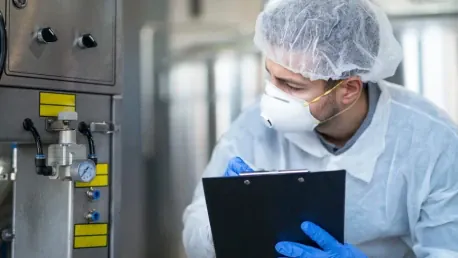Food recalls have become a growing concern in both the European Union (EU) and the United States (US), posing significant risks to manufacturers’ reputations and financial stability. With direct recall costs estimated around $10 million, the indirect costs can be even more substantial and long-lasting. This escalating issue has led major food retailers to implement stringent inspection standards, compelling suppliers to adopt advanced detection technologies to ensure food safety and maintain market access.
The Rising Impact of Food Recalls
Food recalls can severely damage a manufacturer’s reputation and financial health. The direct costs of a recall, including logistics, disposal, and legal fees, are estimated to be around $10 million. However, the indirect costs—such as lost sales, brand damage, and decreased consumer trust—can be even more detrimental and long-lasting. As a result, food recalls have become a significant concern for the industry.
The Financial and Reputational Consequences
The financial impact of food recalls extends beyond immediate costs. Companies often face long-term financial repercussions, including lost sales and decreased market share. Additionally, the reputational damage can lead to a loss of consumer trust, which is difficult to rebuild. This has prompted food manufacturers to prioritize food safety and invest in advanced detection technologies to mitigate the risk of recalls.
Major food recalls can trigger a domino effect that jeopardizes the very foundation of a company’s market standing. Beyond the initial logistical nightmare of withdrawing products, discarding contaminated batches, and managing legal implications, recalls often result in a steep decline in consumer confidence and loyalty. This erosion of trust can be more damaging than the recall’s direct financial impact, as regaining a loyal customer base is a slow, costly process. Food manufacturers, therefore, face the dual challenge of addressing immediate recall-related expenses while simultaneously working toward reputational recovery and market stability.
The Role of Retailers in Driving Standards
Major food retailers in the EU and US have responded to the rise in food recalls by implementing stringent inspection standards. These standards are designed to ensure that suppliers meet high levels of food safety and quality. Retailers like Marks and Spencer in the UK have set the benchmark with rigorous standards, which are now considered the gold standard in the industry. US retailers are following suit, emphasizing the need for suppliers to adopt these standards or risk losing shelf placement.
Retailers wield significant influence over the supply chain, as they hold the power to enforce quality and safety protocols upon suppliers. Consequently, leading retailers in both the EU and the US have begun to establish specific, rigorous inspection standards to mitigate the risk of contaminated products reaching consumers. Marks and Spencer’s demanding guidelines in the UK have gained industry-wide recognition and are frequently used as a model for excellence in food safety. As US retailers adopt similar standards, suppliers must rise to meet these expectations to maintain shelf space and market share, underscoring the retail sector’s pivotal role in driving food safety advancements.
Foreign Object Detection Technologies
To address the issue of food recalls, manufacturers are increasingly turning to advanced foreign object detection technologies. Two critical technologies in this area are metal detection and X-ray inspection. These technologies play a vital role in ensuring food safety by identifying and removing contaminants from the production line.
Metal Detection: Cost-Effective and Reliable
Metal detectors are widely used in the food industry to detect ferrous, non-ferrous metals, aluminum, and stainless steel. These devices work by using balanced coil designs that affect a high-frequency radio field. Metal detection technology is cost-effective, durable, and ideal for products with varied speeds, especially dry, non-conductive products.
One of the primary advantages of metal detection systems lies in their simplicity and adaptability. By generating a high-frequency electromagnetic field, these systems can identify the presence of metallic contaminants by detecting disruptions in this field. This method proves particularly effective in detecting ferrous and non-ferrous metals as well as stainless steel, which may inadvertently enter the production line. The cost-effectiveness of metal detectors, combined with their robust design and ease of maintenance, renders them an attractive option for manufacturers seeking reliable solutions to enhance food safety without incurring exorbitant expenses.
Advanced Metal Detection Systems
Advanced metal detection systems are capable of handling more challenging products, such as moist, salty foods and metallic packaging. These systems offer higher performance through multi-frequency operations, allowing for greater sensitivity and accuracy in detecting contaminants. This makes them suitable for a wide range of food products and packaging types.
When dealing with complex products that pose significant detection challenges, advanced metal detection systems provide a crucial line of defense. Multi-frequency technology enables these systems to distinguish between the scattered signals of contaminants and the inherent properties of high-moisture or salty foods. Additionally, metal detectors that incorporate sophisticated algorithms and adaptable detection capabilities ensure that even trace amounts of metals within problematic packaging materials are reliably identified, mitigating the risk of contaminated products reaching consumers. The versatility of such advanced systems ensures manufacturers can safeguard a broad spectrum of food products, maintaining safety across diverse production lines.
Benefits and Limitations
While metal detection is a reliable and cost-effective solution, it does have some limitations. For example, it may struggle to detect non-metallic contaminants, such as glass or plastic. Additionally, the sensitivity of metal detectors can be affected by the product’s properties, such as moisture content and packaging materials. Despite these limitations, metal detection remains a crucial technology for ensuring food safety.
Limited detection capabilities mean that manufacturers cannot solely rely on metal detection to address all foreign object risks. For instance, contaminants like glass shards and plastic fragments, which pose significant health hazards, may elude detection by metal detectors. Furthermore, products with high moisture content or those encased in certain packaging materials can interfere with the device’s sensitivity, potentially leading to undetected contaminants. Nevertheless, metal detection systems are indispensable in their ability to swiftly and economically identify metallic foreign objects, making them a key component within an integrated approach to food safety.
X-ray Inspection: Comprehensive Contaminant Detection
X-ray inspection systems offer a more comprehensive solution for detecting a wide range of contaminants, including metals, glass, bone, rock, and certain plastics. These systems work by analyzing the energy loss when X-rays penetrate the product, revealing contaminants as darker shaded areas. X-ray inspection is suitable for both conveyor and bulk products, including those in metal cans or metallicized packaging.
X-ray inspection technology operates on the principle of differential absorption, where contaminants generally absorb more X-ray energy than the surrounding product, creating contrast on the X-ray image. This allows for the identification of a variety of foreign objects, from metal fragments to non-metallic materials like glass and bone. By using sophisticated imaging software, these systems can differentiate contaminants from the product matrix, ensuring that even in complex scenarios, foreign objects are reliably detected. This makes X-ray inspection ideal for applications where traditional metal detection may fall short, offering a holistic solution for contamination control.
Versatility and Accuracy
X-ray inspection systems are highly versatile and can be used for a variety of food products and packaging types. They are particularly effective for detecting non-metallic contaminants, which metal detectors may miss. Additionally, X-ray systems can handle products in metal cans or metallicized packaging, making them a valuable tool for ensuring food safety across different product lines.
The flexibility of X-ray systems lies in their ability to adapt to different production environments and varying product characteristics. Whether dealing with raw ingredients, processed foods, or finished products within complex packaging, X-ray technology provides precise detection capabilities. The ability to identify diverse contaminants, including those in metal cans or metallized packages, further highlights the efficacy of X-ray systems in comprehensive quality assurance programs. This adaptability ensures that X-ray inspection remains a preferred choice for manufacturers striving to uphold rigorous safety standards across their entire product range.
Challenges and Considerations
Despite their advantages, X-ray inspection systems also have some challenges. For example, they can be more expensive to purchase and maintain compared to metal detectors. Additionally, the effectiveness of X-ray systems can be influenced by factors such as product density and packaging materials. Manufacturers must carefully evaluate these factors when choosing the right detection technology for their needs.
The higher initial investment and maintenance costs associated with X-ray inspection systems can be a significant consideration for manufacturers. However, these costs must be weighed against the potential benefits of comprehensive contaminant detection and the reduced risk of costly recalls and associated reputational damage. Additionally, factors like product density and varying material properties can affect the accuracy of X-ray detection, necessitating a well-planned implementation strategy to ensure optimal performance. A thorough evaluation of these factors and a clear understanding of operational needs are critical steps in selecting the most suitable detection technology.
Best Practices for Effective Detection
To ensure effective foreign object detection, manufacturers must consider several factors, including the size and nature of contaminants, as well as the properties of the food and packaging. Moist, salty foods and metallic packaging pose specific challenges that require advanced detection technologies and careful calibration.
Balancing Sensitivity and Production Speed
Maintaining production schedules without disruptions is critical for manufacturers. This requires a balance between detection sensitivity and false rejection rates. High sensitivity can lead to false rejections, which can disrupt production and increase costs. Manufacturers must find the right balance to ensure food safety without compromising efficiency.
Finding the right balance between detection sensitivity and production efficiency is crucial for smooth operations. High sensitivity detection systems are capable of identifying minute contaminants, but they may also result in a higher number of false rejections, where harmless products are incorrectly flagged as contaminated. While precise detection is important for food safety, excessive false rejections can lead to unnecessary wastage, production delays, and increased operational costs. Manufacturers must therefore calibrate their detection systems to maintain an optimal balance that ensures robust contaminant identification while minimizing disruptions and maintaining overall production efficiency.
Long-Term Compliance and Cost Considerations
Food recalls are an increasing concern in both the European Union (EU) and the United States (US). They pose significant threats to both the reputation and financial stability of manufacturers. The direct costs associated with a single recall event are estimated to be around $10 million. However, the indirect costs can be even more substantial and persist for a long time. These financial burdens include loss of consumer trust, legal fees, and increased insurance premiums.
Due to the rising frequency of food recalls, major food retailers have begun to enforce more stringent inspection standards. These heightened requirements put pressure on suppliers to adopt advanced detection technologies. Such technologies include high-tech screening procedures and more rigorous quality control systems to ensure the safety of food products. This ensures that the suppliers can maintain their market access and consumer confidence. Ultimately, ensuring food safety is essential not only for public health but also for the economic well-being of food manufacturers and retailers alike.









